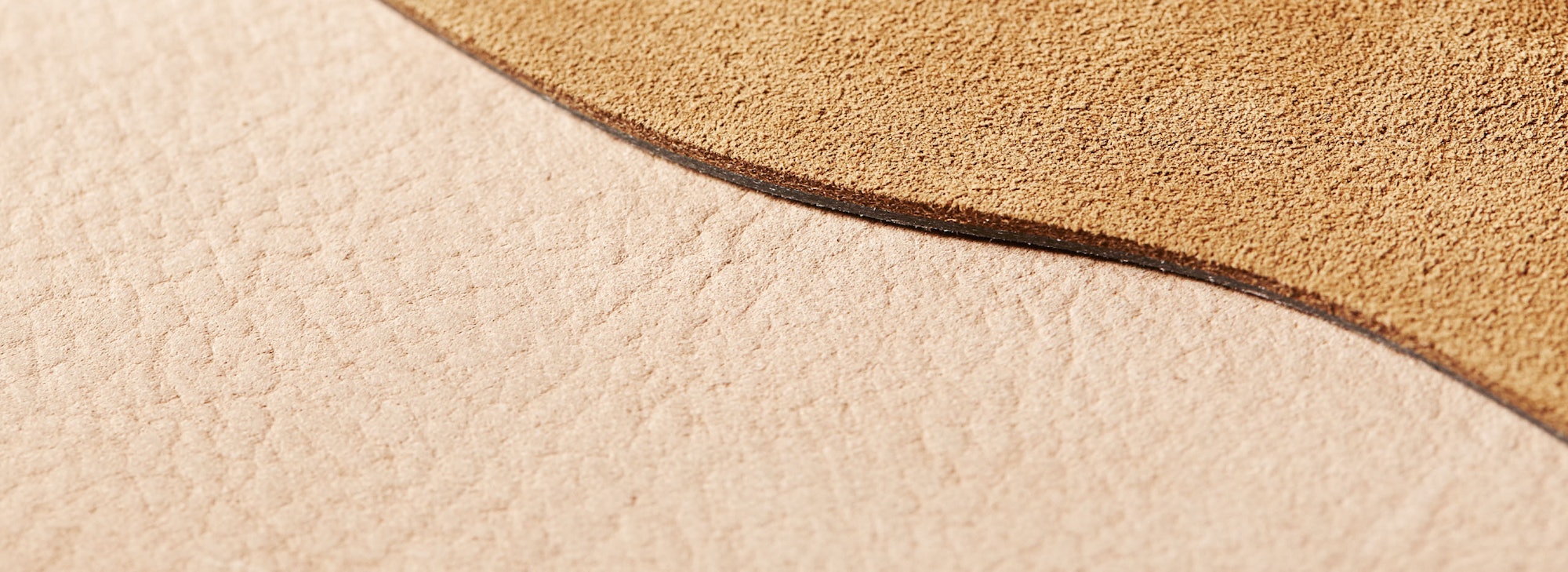Material
As leather experts, we believe that real leather is a great natural and strong material, that is able to withstand years of wear.

Leather sourcing
Full grain leather
Full grain leather is the highest quality leather, featuring the complete grain layer without any surface alterations. This type of leather retains the natural texture and markings of the hide, offering unparalleled durability, breathability, and the ability to develop a unique patina over time, enhancing its aesthetic appeal. Ideal for high-end leather goods, full grain leather is preferred for its strength and ability to withstand wear while maintaining its rich texture and depth of colour.
Suede
Suede is a type of leather with a soft surface, made from the underside of hide. It is characterized by its velvety surface that results from sanding the underside of leather. This process reveals the leather's natural texture, making it exceptionally soft to the touch. Our cow suede combines the durability inherent to cowhide with the luxurious feel of suede. It is perfectly suitable for everyday use while giving the high-fashion appeal.
Nappa leather
Nappa leather is a high-quality, soft, and supple leather, known for its smooth texture and luxurious feel. It is made from the skins of sheep, lambs, or sometimes goats, and is treated to provide an exceptionally soft touch. Nappa leather is characterized by its flexibility and durability, making it a popular choice for high-end fashion items. Its fine grain and buttery feel distinguish it from other types of leather, offering both comfort and elegance.
Embossed grain
Embossed grain leather is a processed leather where a pattern has been imprinted on the surface of the hide through high pressure and heat. This technique can mimic various textures, such as exotic animal skins or geometric designs, offering a unique aesthetic appeal. The embossing process can be applied to different types of leather, enhancing their visual interest. Embossed grain leather provides both durability and a distinctive style.
Split leather
Split leather is made from the lower layers of a hide that have been separated from the grain layer. It often is treated with finish to simulate the appearance of full grain leather. Split leather marries tradition with innovation, presenting a material that is both versatile and enduring.
Bonded leather
Bonded leather is a composite material made from a mixture of shredded leather scraps and fibers, which are bonded together with polyurethane or latex onto a fiber sheet. The surface is then embossed to give it the appearance of genuine leather.This material is cost-effective and environmentally friendly, utilizing leftovers from leather manufacturing.
Metal details and nickel
All of the metal detailing on our products is what you would call “nickel free”. We carry out ongoing tests and systematic random testing of nickel levels in order to ensure that they meet our own, as well as the current legal, requirements. All of this is to ensure that we create a product that is as good as it can possibly be, and so that you as a customer can feel safe.
However, you should be aware that any product made out of metal, or a metal alloy, is in most cases not 100 % nickel free. A product that is labelled “nickel free” by us, and most others in the business, will however follow the guidelines provided by the Swedish Chemicals Agency (a centralised regulator under the Ministry of the Environment), which provide the limit value for how much nickel may be released from a product. That limit value is today set at 0.5 micrograms per cm2 per week, which we adhere to with all of our products. In the document provided below, you can read more about the Swedish Chemicals Agency’s regulations surrounding nickel.
